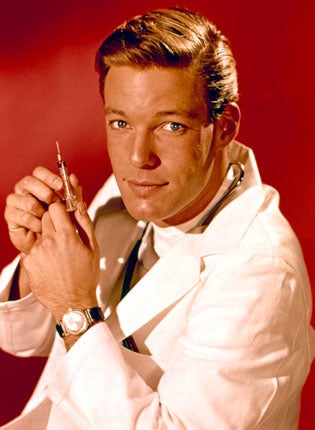Men in white coats return to the nation's hospital wards

Your support helps us to tell the story
From reproductive rights to climate change to Big Tech, The Independent is on the ground when the story is developing. Whether it's investigating the financials of Elon Musk's pro-Trump PAC or producing our latest documentary, 'The A Word', which shines a light on the American women fighting for reproductive rights, we know how important it is to parse out the facts from the messaging.
At such a critical moment in US history, we need reporters on the ground. Your donation allows us to keep sending journalists to speak to both sides of the story.
The Independent is trusted by Americans across the entire political spectrum. And unlike many other quality news outlets, we choose not to lock Americans out of our reporting and analysis with paywalls. We believe quality journalism should be available to everyone, paid for by those who can afford it.
Your support makes all the difference.The doctor's white coat, thought to have been consigned to history as outdated, intimidating for patients and an infection risk, is making a comeback.
Once as distinctive of the medical profession as the stethoscope, the garment disappeared from hospitals 20 years ago as doctors climbed down from their pedestals and sought a more informal relationship with their patients.
Psychiatrists and paediatricians, anxious to be approachable, led the charge and slowly other specialties fell into line.
But the new spirit of egalitarianism has made doctors invisible on the wards and patients now complain they cannot tell a surgeon from a secretary. If doctors are indistinguishable they appear undistinguished, the argument goes.
York Hospitals NHS Foundation Trust is to introduce uniforms for doctors this autumn, Guys and St Thomas' has made white coats mandatory for all junior doctors and medical students. West Middlesex launched its uniform in 2007.
The uniforms, which vary, all have short sleeves to comply with the national "bare below the elbows" policy, a hygiene requirement to make it easier for staff to wash their hands. York and West Middlesex have opted for a blue "scrubs" style garment, as worn in operating theatres, while St Thomas' chose a shortened version of the traditional white coat.
Alastair Turnbull, consultant gastroenterologist and medical director at York, said that before the uniform was introduced he had cut the arms off three of his jackets to comply with the bare below the elbows policy, introduced in 2008. "I thought I would set an example but people said to me, 'Alastair, you are taking the piss.' It didn't work."
Later a junior doctor at York mislaid confidential patient notes which were passed to the local paper. An investigation concluded they were lost because juniors did not have large enough pockets to carry them in.
"We decided to make it easier for juniors to be bare below the elbow and to carry patient notes and we proposed a pilot of a uniform with large pockets," Dr Turnbull said. "It was opposed by the local branch of the British Medical Association, and some doctors, who felt coerced. But patients have an expectation that doctors will look smart.
"Other professions such as the military and the law are expected to appear professional and this is no different. It is difficult to see why there should be more of a barrier if you are facing a consultant in a suit and tie than in a white coat."
Guy's and St Thomas' said the subject of uniforms always provoked fierce debate. Infection control specialists complained that white coats harboured germs. But defenders of the garments said they had been maligned and the real reason they became unhygienic was the removal of hospital laundry facilities. At Guy's and St Thomas', white coats are dispensed and laundered by the trust.
Public recognition was also an important factor, the trust said: "People expect if you go into hospital you will be able to tell who is a doctor. People want to know who is treating them."
At West Middlesex, the trust attributes falling infection rates and high compliance with the bare below the elbow policy – for which it was commended by the Care Quality Commission in 2009 – to its uniform. "The bottom line for us was patient safety," it said.
White coats are still in favour in other countries. In the US, white coat "robing ceremonies" are common. They were adopted by doctors in the mid-19th century because white represented purity and cleanliness. But today, non-medical staff from pharmacists to mortuary attendants wear white coats. So doctors are switching to blue tunics, as worn in operating theatres, known as scrubs.
The BMA said the re-introduction of white coats or other uniforms for doctors was a matter for "local discussion and negotiation".
Join our commenting forum
Join thought-provoking conversations, follow other Independent readers and see their replies
Comments